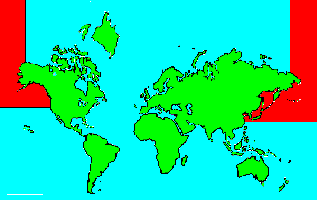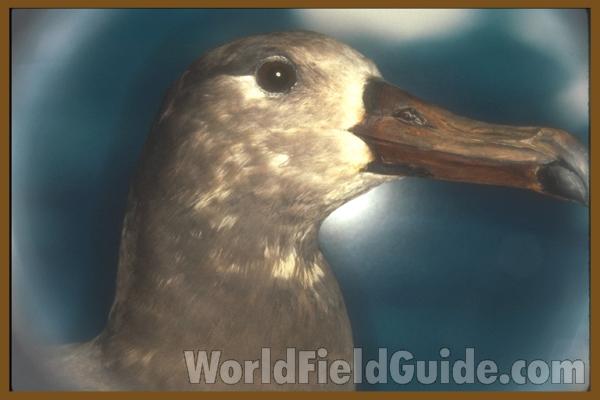SPECIES INFO
Black Footed Albatross (Diomedea nigripes equal Phoebastria nigripes) breeds on the islands of the north Pacific Ocean. This is known to breed near Japan and near Hawaii. It can be found in the open ocean as far south as Mexico. Although this gray bird is only about thirty inches long, its wingspan is close to seven feet.
There are no recognized subspecies.
This bird is on watchlists, and as of 2010 it was estimated that only about 150,000 individuals remained. The populations are decreasing. Breeding sites are now protected in both Hawaii and Japan. Efforts are underway to protect birds from commercial fishing.There are 4 species in this genus. Previously, they were included in the Diomedea genus. Three of these species can be found as far north as Japan and Hawaii. These are open ocean birds that can be seen flying over the waves, or resting on top of the water.
These birds have long narrow wings that can have wingspans of over 7 feet.
Albatross Family (Diomedeidae) contains about thirteen or fourteen species of large-bodied birds with long pointed wings.
Most Albatrosses are excellent gliders, but not such excellent fliers. Albatrosses need various wind currents to help them stay aloft, and consequently, they are most numerous in the windy oceans of the world.
The largest Albatross, the Wandering Albatross (Diomedea exulans) has a wing span of ten to eleven feet. This species breeds in the South Pacific. Young take to the wing, and fly and glide for about seven years before returning to their island origins to breed.
Fishermen, in the search for Bluefin Tuna, string out long lines behind their boats with hundreds of hooks and pieces of squid. The squid, one of the natural foods for the albatross attracts the birds, and they kill themselves in attempting to feed on the squid. It is felt that this practice could be killing up to 44,000 Wandering Albatross per year.
Amsterdam Albatross (Diomedea amsterdamensis) breeds only on the Amsterdam Island in the Indian Ocean. In l985, it was observed that only about five pairs of this species were breeding per year.
Short Tail Albatross (Diomedea albanus) breeds only on Torishima, a volcanic island south of Japan. Feather hunting and volcanic eruptions almost brought this species to extinction. In 1986, the population on Torishima was estimated at 146 adults and 77 young.
Tube Nosed Swimmers (Order Procellariiformes) contains three families of primarily marine birds. There are about 114 different species in this order. The albatrosses, shearwaters, storm petrels, and diving petrels are contained in this order.
Aves contains about 8,650 different species of living birds known to science. Each year about one new species is discovered in some remote rain forest or remote island. In addition, scientists have been raising many subspecies to full species status which may raise the species count to 10,000. Birdlife recognizes 10,027 species as of 2011.
However, each year about one species goes extinct. The rate of extinction is increasing, and the rate of new discovery is decreasing, so that the number of bird species will soon begin to decline rapidly. Although different taxonomists would organize the birds differently, there are approximately twenty-seven orders of birds. These orders are broken down into about one hundred and fifty-five different families.
Recent research of the genetic structure of some of the shore birds and owls would indicate that the present organization of orders and families should have some modification.
The birds are a worldwide group of animals that are characterized by having the front limbs modified into wings that are used for flying. Perhaps the most unique feature of the birds is the feathers. These feathers are made up of a central support called a quill and a series of small filaments that are hooked together as barbs.
For many years it was believed that Archaeopteryx discovered in Bavaria was the oldest bird from about 150 million years ago. However, in l986, Sankar Chattterjee, a Texas paleontologist, reportedly discovered a bird in the genus Protoavis that lived about 225 million years ago.
When this project was begun in 1978, we used Austin & Singer for bird taxonomy. Since then, we have adopted many changes, but have kept some older concepts that are still found widely in the literature. Recently, we have used Clements and Howard & Moore. Very recently, we have used Monroe and Sibley for the higher taxonomy of the perching birds.
Backboned Animals (Phylum Chordata) are the most advanced group of animals on earth. These animals are characterized by having a spinal cord or backbone. Most members have a clearly defined brain that controls the organism through a spinal cord. Fish, amphibians, reptiles, birds, and mammals are in this phylum.
Currently, some taxonomists believe that the fish should be divided into two groups (sharks and regular fishes) and that there are some other primitive groups in the phylum such as hagfish or lampreys.
Animal Kingdom contains numerous organisms that feed on other animals or plants. Included in the animal kingdom are the lower marine invertebrates such as sponges and corals, the jointed legged animals such as insects and spiders, and the backboned animals such as fish, amphibians, reptiles, birds, and mammals.


